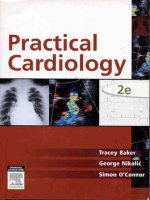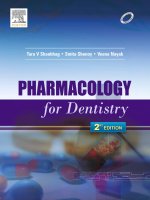Ebook Emergencies in cardiology (2nd edition): Part 1
Bạn đang xem bản rút gọn của tài liệu. Xem và tải ngay bản đầy đủ của tài liệu tại đây (2.32 MB, 374 trang )
4—A true life-threatening emergency. Memorizing these conditions may
help. Call immediately for assistance. Try to remain calm and quickly assess
ABC. Once the problem has been dealt with remember to reassess- other
problems may have been forgotten or missed in the heat of the moment.
3—These patients need to be assessed very quickly, because they can
rapidly deteriorate. Consider senior help/advice.
2—These conditions require careful assessment and correction but are
less likely to become life-threatening emergencies.
1—These conditions are non-urgent, or cover general guidance.
OXFORD MEDICAL PUBLICATIONS
Emergencies in
Cardiology
Second edition
Published and forthcoming titles in the Emergencies
in… series:
Emergencies in Anaesthesia
Edited by Keith Allman, Andrew McIndoe, and Iain H. Wilson
Emergencies in Cardiology
Edited by Saul G. Myerson, Robin P. Choudhury, and Andrew Mitchell
Emergencies in Clinical Surgery
Edited by Chris Callaghan, J. Andrew Bradley, and Christopher Watson
Emergencies in Critical Care
Edited by Martin Beed, Richard Sherman, and Ravi Mahajan
Emergencies in Nursing
Edited by Philip Downing
Emergencies in Obstetrics and Gynaecology
Edited by S. Arulkumaran
Emergencies in Oncology
Edited by Martin Scott-Brown, Roy A.J. Spence, and Patrick G. Johnston
Emergencies in Paediatrics and Neonatology
Edited by Stuart Crisp and Jo Rainbow
Emergencies in Palliative and Supportive Care
Edited by David Currow and Katherine Clark
Emergencies in Primary Care
Chantal Simon, Karen O’Reilly, John Buckmaster, and Robin Proctor
Emergencies in Psychiatry
Basant K. Puri and Ian H. Treasaden
Emergencies in Clinical Radiology
Edited by Richard Graham and Ferdia Gallagher
Emergencies in Respiratory Medicine
Edited by Robert Parker, Catherine Thomas, and Lesley Bennett
Head, Neck and Dental Emergencies
Edited by Mike Perry
Medical Emergencies in Dentistry
Nigel Robb and Jason Leitch
Emergencies
in Cardiology
Saul G. Myerson
Consultant Cardiologist,
John Radcliffe Hospital,
Honorary Senior Clinical Lecturer,
University of Oxford
Oxford
Robin P. Choudhury
Wellcome Trust Senior Clinical Fellow
Clinical Director,
Oxford Acute Vascular Imaging Centre
Honorary Consultant Cardiologist
John Radcliffe Hospital, Oxford
Andrew R. J. Mitchell
Consultant Cardiologist,
Jersey General Hospital
1
1
Great Clarendon Street, Oxford OX2 6DP
Oxford University Press is a department of the University of Oxford.
It furthers the University’s objective of excellence in research, scholarship,
and education by publishing worldwide in
Oxford New York
Auckland Cape Town Dar es Salaam Hong Kong Karachi
Kuala Lumpur Madrid Melbourne Mexico City Nairobi
New Delhi Shanghai Taipei Toronto
With offices in
Argentina Austria Brazil Chile Czech Republic France Greece
Guatemala Hungary Italy Japan Poland Portugal Singapore
South Korea Switzerland Thailand Turkey Ukraine Vietnam
Oxford is a registered trade mark of Oxford University Press
in the UK and in certain other countries
Published in the United States
by Oxford University Press Inc., New York
© Oxford University Press, 2010
The moral rights of the author have been asserted
Database right Oxford University Press (maker)
First published 2006
Euromedice edition published 2007
Second edition published 2010
All rights reserved. No part of this publication may be reproduced,
stored in a retrieval system, or transmitted, in any form or by any means,
without the prior permission in writing of Oxford University Press,
or as expressly permitted by law, or under terms agreed with the appropriate
reprographics rights organization. Enquiries concerning reproduction
outside the scope of the above should be sent to the Rights Department,
Oxford University Press, at the address above
You must not circulate this book in any other binding or cover
and you must impose this same condition on any acquirer
British Library Cataloguing in Publication Data
Data available
Library of Congress Cataloging in Publication Data
Data available
Typeset by Cepha Imaging Private Ltd., Bangalore, India
Printed in China
on acid-free paper by
Asia Pacific Offset Limited
ISBN 978–0–19–955438–6
10 9 8 7 6 5 4 3 2 1
Oxford University Press makes no representation, express or implied, that the drug
dosages in this book are correct. Readers must therefore always check the product
information and clinical procedures with the most up to date published product
information and data sheets provided by the manufacturers and the most recent
codes of conduct and safety regulations. The authors and publishers do not accept
responsibility or legal liability for any errors in the text or for the misuse or misapplication of material in this work. Except where otherwise stated, drug dosages and
recommendations are for the non-pregnant adult who is not breast-feeding.
v
Preface
Acute cardiology problems often need quick, appropriate diagnosis and
treatment. With the increasing complexity and rapidly-changing nature of
available therapies, knowing which to use and in what situation can be
difficult. This book provides an easily accessible guide to diagnosing and
managing acute cardiovascular problems and is designed for busy medical
and cardiology teams, with expert advice in a clear, concise format. The
familiar Oxford Handbook style, with bullet-point information for speed
and clarity, is combined with an integral cross-referencing system, enabling
rapid access to the necessary information.
This second edition incorporates much of the feedback received from the
first edition, and includes updated sections throughout, with significantly
expanded sections on myocardial infarction, heart failure, and cardiac
problems in pregnancy. There is a new chapter on cardiac drugs and a
separate chapter for infective endocarditis. The layout is even clearer
than before, with improved text, several new illustrations, algorithms and
ECG’s and additional practical procedure guidance including exercise ECG
interpretation and intra-aortic balloon pumps.
The first section of the book is symptom based and is designed to help
clinch the diagnosis with suggestions of the key points in the history, physical findings and investigations and extensive cross-referencing to specific
cardiac conditions later in the book.
The second section “Specific conditions” describes the presentation, investigation and management of all the common (and some uncommon) acute
cardiac problems. The chapter authors have used their specialist knowledge to guide management in all areas, including potentially challenging
problems such as arrhythmias (and implantable defibrillators), cardiac
issues in pregnancy, cardiac problems around the time of surgery, adults
with congenital heart disease, and cardiac trauma.
The final section deals with “practical issues”, with clear descriptions of
how to perform common practical cardiac procedures. It also includes a
chapter on the art of ECG recognition with a library of example ECGs to
help pattern recognition.
We hope that you enjoy the new edition of the book and use it to enhance
the care of your patients. We welcome further suggestions for alterations
and inclusions in future editions.
This page intentionally left blank
vii
Contents
Contributors ix
Symbols and abbreviations xi
1
2
3
4
5
6
7
8
9
10
11
12
13
14
15
16
17
18
19
Part I Presentation: making the diagnosis
Cardiovascular collapse
Chest pain
Shortness of breath
Syncope
Palpitation
3
13
19
23
33
Part II Specific conditions
Acute coronary syndromes
Acute heart failure
Valve disease
Infective endocarditis
Arrhythmias
Aortic dissection
Pericardial disease
Pulmonary vascular disease
Systemic emboli
Cardiac issues in pregnancy
Adult congenital heart disease
Perioperative care
Cardiac drugs: effects and cardiotoxicity
Miscellaneous conditions
39
67
93
121
137
189
203
213
227
235
253
291
309
347
viii
CONTENTS
Part III Practical issues
20 Practical procedures
21 ECG recognition
Index 431
359
383
ix
Contributors
Dr Kaleab Asrress
Dr Jo D’Arcy
Registrar in Cardiology
General Hospital
St. Helier
Jersey
Pulmonary vascular disease
Shortness of breath
Cardiology Registrar
John Radcliffe Hospital
Oxford
Acute heart failure
Dr Adrian Banning
Consultant Cardiologist
John Radcliffe Hospital
Oxford
Aortic dissection
Prof. Harald Becher
Consultant Cardiologist
John Radcliffe Hospital
Oxford
Pericardial disease
Dr Tim Betts
Dr Jeremy Dwight
Consultant Cardiologist
John Radcliffe Hospital
Oxford
Acute heart failure
Prof. Pierre Foex
Professor of Anaesthesia
Nuffield Dept. of Anaesthesia
John Radcliffe Hospital
Oxford
Perioperative care
Prof. Michael Gatzoulis
Consultant Cardiologist and
Electrophysiologist
John Radcliffe Hospital
Oxford
Arrhythmias
Consultant Cardiologist
Adult Congenital Heart Disease
and Pulmonary Hypertension Unit,
Royal Brompton Hospital
London
Adult congenital heart disease
Prof. Keith Channon
Dr George Giannakoulas
Oxford University Dept. of
Cardiovascular Medicine
John Radcliffe Hospital
Oxford
Acute coronary syndromes
Clinical Research Fellow
Adult Congenital Heart Disease
and Pulmonary Hypertension Unit,
Royal Brompton Hospital
London
Adult congenital heart disease
Dr Robin Choudhury
Wellcome Trust Senior Clinical
Fellow
Oxford University Dept. of
Cardiovascular Medicine;
Honorary Consultant Cardiologist
John Radcliffe Hospital
Oxford
Acute coronary syndromes
Chest pain
Perioperative care
Dr Lucy Hudsmith
Registrar in Cardiology
John Radcliffe Hospital
Oxford
Cardiac issues in pregnancy
x
CONTRIBUTORS
Dr Andrew R. J. Mitchell
Cardiovascular collapse
Consultant Cardiologist
General Hospital
St. Helier
Jersey
Aortic dissection
Pulmonary vascular disease
Shortness of breath
Miscellaneous conditions
Dr Cheerag Shirodaria
Dr Steve Murray
Consultant Cardiologist
The Cardiothoracic Centre
Liverpool
Practical procedures
Consultant Cardiologist and
Electrophysiologist
The Freeman Hospital
Newcastle
ECG recognition
Dr Saul G. Myerson
Consultant Cardiologist
John Radcliffe Hospital;
Honorary Senior Clinical Lecturer
University of Oxford
Oxford
Chest pain
Infective endocarditis
Palpitation
Perioperative care
Valve disease
Registrar in Cardiology
John Radcliffe Hospital
Oxford
Cardiac drugs: effects and
cardiotoxicity
Dr Rodney Stables
Dr Jonathan Timperley
Consultant Cardiologist
Northampton General Hospital
Northampton
Systemic emboli
Dr Sara Thorne
Consultant Cardiologist in Adult
Congenital Heart Disease
University Hospital Birmingham
Birmingham
Cardiac issues in pregnancy
Dr Anselm Uebing
Department of Cardiology
John Radcliffe Hospital
Oxford
Cardiac drugs: effects and
cardiotoxicity
Department of Paediatric
Cardiology
University Hospital of
Schleswig-Holstein
Kiel
Germany
Adult congenital heart disease
Dr Mark Petersen
Dr Kelvin Wong
Dr Sheraz Nazir
Consultant Cardiologist
Gloucester Royal Hospital
Gloucestershire
Syncope
Department of Cardiology
John Radcliffe Hospital
Oxford
Arrhythmias
Dr Jon Salmon
Consultant Physician
Adult Intensive Care Unit
John Radcliffe Hospital
Oxford
The authors are grateful to Louise Beaumont, Medicines Information &
Cardiology Pharmacist, John Radcliffe Hospital, Oxford for her diligent
work in checking the drugs and doses
xi
Symbols and
Abbreviations
b
0
2
3
6
i
d
l
Z
p
s
>
<
~
6
cross reference
warning
important
don’t dawdle
therefore
increased
decreased
leading to
differential diagnosis
primary
secondary
greater than
less than
approximately
website
therefore
3D
5-FU
ACE
ACHD
ACS
ACT
ADP
AF
ANA
AP
AR
ARVC
AS
ASAP
ASD
ASO
AST
ATP
three-dimensional
5-fluorouracil
angiotensin-converting enzyme
adult congenital heart disease
acute coronary syndrome
activated clotting time
adenosine diphosphate
atrial fibrillation
antinuclear antibody
action potential
aortic regurgitation
arrhythmogenic right ventricular cardiomyopathy
aortic stenosis
as soon as possible
atrial septal defect
antistreptolysin O
aspartate aminotransferase
antitachycardia pacing
xii
SYMBOLS AND ABBREVIATIONS
AV
AVNRT
AVR
AVRT
AVSD
BD
BNP
BP
BT
CABG
ccTGA
CHB
CK
cm
CMR
CNS
COPD
COX
CPAP
CPR
CRP
CT
CTPA
CVP
CXR
DC
DCM
DIC
DVT
ECG
ECMO
EMI
ESR
FBC
FFP
g
GA
GI
GP
GTN
atrioventricular
atrioventricular nodal re-entry tachycardia
aortic valve replacement
atrioventricular re-entry tachycardia
atrioventricular septal defect
twice daily
brain natriuretic peptide
blood pressure
Blalock–Taussig
coronary artery bypass graft
congenitally corrected transposition of the great arteries
complete heart block
creatine kinase
centimetre/s
cardiovascular magnetic resonance
central nervous system
chronic obstructive pulmonary disease
cyclooxygenase
continuous positive airway pressure
cardio-pulmonary resuscitation
C-reactive protein
computed tomography
computed tomography pulmonary angiography
central venous pressure
chest X-ray
direct current
dilated cardiomyopathy
disseminated intravascular coagulation
deep vein thrombosis
electrocardiogram
extracorporeal membrane oxygenation
electromagnetic interference
erythrocyte sedimentation rate
full blood count
fresh frozen plasma
gram/s
general anaesthetic
gastrointestinal
general practitioner
glyceryl trinitrate
SYMBOLS AND ABBREVIATIONS
HACEK
HCM
HDL
HDU
HR
IABP
ICD
ICU
IHD
IM
INR
IV
IVC
JVP
LA
LAD
LBBB
LDL
LFT
LV
LVF
LVOT
m
MAP
mcg
MCV
MI
min
mL
MR
MRI
MS
msec
N/saline
NSAID
NSTEMI
OD
PCI
PCR
Haemophilus species, Actinobacillus actinomycetemcomitans,
Cardiobacterium hominis, Eikenella corrodens, and
Kingella species
hypertrophic cardiomyopathy
high-density lipoprotein
High Dependency Unit
heart rate
intra-aortic balloon pump
implantable cardioverter defibrillator
Intensive Care Unit
ischaemic heart disease
intramuscular
international normalized ratio
intravenous
inferior vena cava
jugular venous pressure
left atrium/atrial
left anterior descending
left bundle branch block
low-density lipoprotein
liver function test
left ventricle/ventricular
left ventricular failure
left ventricular outflow tract
metre/s
mean arterial pressure
microgram/s
mean corpuscular volume
myocardial infarction
minute/s
millilitre/s
mitral regurgitation
magnetic resonance imaging
mitral stenosis
millisecond
normal saline
non-steroidal anti-inflammatory drug
non-ST segment elevation myocardial infarction
once daily
percutaneous coronary
polymerase chain reaction
xiii
xiv
SYMBOLS AND ABBREVIATIONS
PCWP
PDA
PE
PEA
PET
PFO
PFT
PLE
PO
PR
PRN
QDS
RA
RBBB
RCA
RV
RVOT
RVOTO
S1
S2
S3
S4
SaO2
SCD
ScvO2
sec
SL
SLE
SOB
SpO2
SR
STEMI
SVC
SVT
TCPC
TDS
TIA
TIMI
TNK
TOE
pulmonary capillary wedge pressure.
patent ductus arteriosus
pulmonary embolism
pulseless electrical activity
positron emission tomography
patent foramen ovale
pulmonary function test
protein-losing enteropathy
per os (orally)
pulmonary regurgitation
when necessary
four times daily
right atium/atrial
right bundle branch block
right coronary artery
right ventricle/ventricular
right ventricular outflow tract
right ventricular outflow tract obstruction
first heart sound
second heart sound
third heart sound
fourth heart sound
arterial oxygen saturation
sudden cardiac death
central venous oxygen saturation
second/s
sublingual
systemic lupus erythematosus
shortness of breath
saturation of peripheral oxygen
sustained release
ST segment elevation myocardial infarction
superior vena cava
supraventricular tachycardia
total cavopulmonary connection
three times daily
transient ischaemic attack
thrombolysis in myocardial infarction
tenecteplase
transoesophageal echocardiogram
SYMBOLS AND ABBREVIATIONS
ToF
TR
TTE
TTP
U&E
URTI
VF
VLDL
VT
VSD
VTE
WCC
WPW
tetralogy of Fallot
tricuspid regurgitation
transthoracic echocardiography
thrombotic thrombocytopenic purpura
urea and electrolytes
upper respiratory tract infection
ventricular fibrillation
very low-density lipoprotein
ventricular tachycardia
ventral septal defect
venous thromboembolism
white cell count
Wolff–Parkinson–White
xv
This page intentionally left blank
Part 1
Presentation:
making the
diagnosis
Chapter 1
Chapter 2
Chapter 3
Chapter 4
Chapter 5
Cardiovascular collapse
Chest pain
Shortness of breath
Syncope
Palpitation
3
13
19
23
33
This page intentionally left blank
Chapter 1
Cardiovascular collapse
Introduction 4
Cardiac arrest 4
Shock 4
Initial assessment 6
Approaching a differential 6
Immediate actions 8
Continuing investigation and treatment 10
3
4
CHAPTER 1
Cardiovascular collapse
Introduction
Cardiovascular collapse is the rapid or sudden development of circulatory
failure. This forms part of a spectrum of shock which encompasses:
• Cardiac arrest
• Shock—overt and compensated.
4Cardiac arrest
Treat immediately according to current guidelines (see Fig. 1.1).
3Shock
• Systolic BP <90 mmHg with features of reduced organ perfusion
In shock, cardiac output may be high (e.g. sepsis) or low (e.g. cardiogenic shock). The common factor is failure of tissue oxygen delivery and/
or tissue oxygen utilization. The clinical presentation depends upon the
severity and speed of onset of the cause and the physiologic reserve of the
host. Determining the cause may be difficult and the diagnosis may only
be apparent following, or during, resuscitation. Pathologies frequently coexist, particularly in the elderly (e.g. cardiac failure complicating sepsis).
2 Assessment and treatment should proceed in parallel.
The immediate priorities are to maintain:
• A safe airway and oxygenation
• Sufficient circulation to perfuse the heart and brain.
When these have been achieved, there is time to refine the diagnosis and
indulge in special investigations and specific treatment while continuing to
resuscitate the circulation.
This may involve a trade-off between giving fluids and vasoactive drugs to
improve the peripheral circulation at the expense of increasing myocardial
work. However, it is critical: failure to restore adequate tissue perfusion
vastly increases mortality and makes all your hard work meaningless.
SHOCK
Unresponsive?
Open airway
Look for signs of life
Call
Resuscitation Team
CPR 30:2
Until defibrillator/monitor
attached
Assess
rhythm
Shockable
Non-Shockable
(VF/pulseless VT)
(PEA/Asystole)
1 Shock
150–360 J biphasic
or 360 J monophasic
Immediately resume
CPR 30:2
for 2 min
During CPR:
• Correct reversible causes*
• Check electrode position
and contact
• Attempt/verify:
IV access airway
and oxygen
• Give uninterrupted
compressions when
airway secure
• Give adrenaline
every 3–5 min
• Consider: amiodarone,
atropine, magnesium
Immediately resume
CPR 30:2
for 2 min
* Reversible Causes
Hypoxia
Tension pneumothorax
Hypovolaemia
Tamponade, cardiac
Hypo/hyperkalaemia/metabolic
Toxins
Hypothermia
Thrombosis (coronary or pulmonary)
Fig. 1.1 The Advanced Life Support universal algorithm for the management of
cardiac arrest in adults. Reproduced with permission from the Resuscitation
Council UK.
5
6
CHAPTER 1
Cardiovascular collapse
Initial assessment
This should be rapid. You need to decide whether the patient can
survive more detailed assessment or whether you must start resuscitating
immediately.
2 If the patient can speak, take a brief, focused history; if not, assess the
patient whilst questioning nursing staff, ambulance personnel, or relatives.
Check immediately
• Airway competence
• Breathing
• Circulation—pulse: rate and character.
Specifically examine
•
•
•
•
•
•
•
•
•
•
Peripheral perfusion, including capillary refill
BP
JVP
Is there a sternotomy scar?
Check the trachea
Percuss the upper chest and listen to air entry to exclude
pneumothorax and for crackles of pulmonary oedema
Listen to the heart. Are there any (possibly new) murmurs?
Quickly feel the abdomen for distension, pulsatile masses etc.
Assess conscious level using the AVPU score:
• A = Awake
• V = responds to Voice only
• P = responds to Pain
• U = Unresponsive
Check capillary blood sugar.
Obtain (or nominate a colleague to obtain)
•
•
•
•
•
•
12-lead ECG
CXR
Arterial blood gas analysis
Urgent biochemistry—U&E, Ca2+, Mg2+, troponin, glucose, CK, amylase
FBC, clotting studies, group and save
If sepsis seems likely, check CRP and send blood cultures.
Approaching a differential
At the end of this you should have sufficient information to make a preliminary diagnosis and assign the patient to one of three main categories:
• Intrinsic cardiogenic
• Extrinsic cardiogenic
• Non-cardiogenic.
See Box 1.1 for causes.
APPROACHING A DIFFERENTIAL
Box 1.1 Causes of shock
Intrinsic cardiogenic
• Acute myocardial failure
• Acute myocardial ischaemia
• Acute valvular lesion
• Cardiodepressant drugs
• Arrhythmia.
Extrinsic cardiogenic
• Pulmonary embolus
• Pericardial tamponade
• Tension pneumothorax.
Non-cardiogenic
• Sepsis
• Anaphylaxis
• Hypovolaemia
• Vasoactive drug toxicity (drug-induced hypotension).
7









